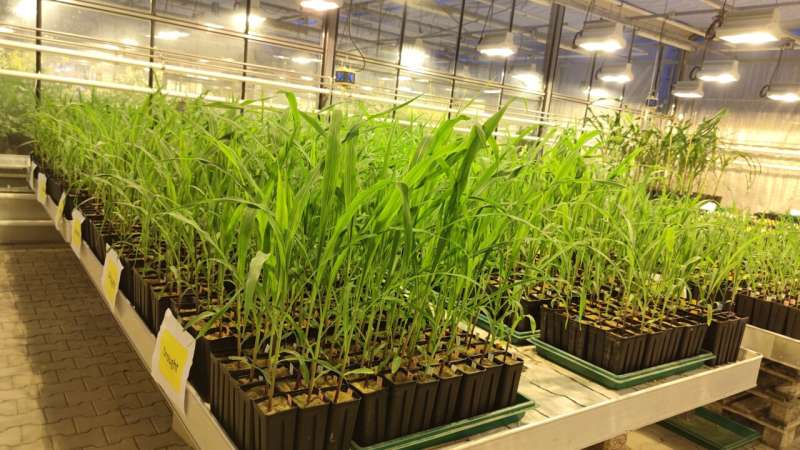This article has been reviewed according to Science X's editorial process and policies. Editors have highlighted the following attributes while ensuring the content's credibility:
fact-checked
peer-reviewed publication
proofread
Researchers identify genetic contribution to the composition of the microbiome around maize roots

In order for plants to grow, they absorb water and nutrients through their roots. In doing so, they rely on tiny helpers: bacteria and fungi in particular are found in a thin layer around the roots. These microbes also ward off organisms that are harmful to the plant, just as the "microbiome" in the human gut helps determine whether we fall ill or stay healthy.
An international research team led by the University of Bonn and with the participation of the IPK Leibniz Institute has now demonstrated on maize plants that the genetic make-up of the host plant has a significant influence on the composition of the root microbes. The research is published in Nature Plants.
"It was shown that the root microbiome is strongly dependent on stress conditions such as nutrient or water deficiency," says Dr. Yong Jiang, one of the first authors of the study and a scientist in IPK's research group "Quantitative Genetics."
The genetic make-up of different maize varieties varies greatly. Regional varieties are adapted to very different environmental conditions, depending on whether they are grown in the cooler highlands or warmer lowlands of South America. "The centuries-long selection of maize varieties adapted to the local climate led to very different genotypes, which we were able to use for the study," says Dr. Peng Yu, head of the junior research group "Functional Root Biology" at the University of Bonn.
The research team has now analyzed 129 maize varieties. These were grown under "normal" conditions and under a lack of phosphorus, nitrogen and water. In addition, the DNA of microbes from 3,168 samples taken from the layer around the roots, which is just a few millimeters thick, was sequenced.
The role of the genetic material in the root was revealed under stress conditions. Nutrient and water deficiency also had an influence on the composition of the microbes. However, under the same stress conditions, differences in the microbiome of the maize varieties were nevertheless revealed. "We have shown that certain maize genes interact with certain bacteria," explains Dr. Peng Yu.
The international research team was even able to use data on the growing conditions at the place of origin of a particular maize variety and its genetic make-up to predict which key organisms occur in the microbiome at the root. Bacteria of the genus Massilia stood out in particular.
"It was striking that only a few specimens of these microbes were present when there was a sufficient supply of nitrogen," explains Prof. Dr. Gabriel Schaaf from the Ecophysiology of Plant Nutrition department at INRES and member of the PhenoRob Cluster of Excellence at the University of Bonn.
If, on the other hand, nitrogen was scarce, many Massilia were found at the roots. The team then "inoculated" maize roots with this bacterium. This showed that the plants subsequently formed many more lateral roots and thus significantly improved their nutrient and water uptake.
In further investigations, the researchers discovered that the root attracts Massilia bacteria with flavones. This is a plant pigment that stimulates the formation of lateral roots with the help of the bacteria. "However, the prerequisite for this was that the maize plant had a microtubule-binding gene," says Dr. Peng Yu.
"For this study, we also opened up the toolbox of quantitative genetics for microbiome research," explains IPK scientist Dr. Yong Jiang. "We were surprised by the large proportion of the genetic component in the formation of the microbiome."
The results can be used by both science and breeding. "They can serve as a basis for investigating further agroecological issues and for developing new maize varieties that are better adapted to climate change based on the genome and microbiome data."
More information: Xiaoming He et al, Heritable microbiome variation is correlated with source environment in locally adapted maize varieties, Nature Plants (2024). DOI: 10.1038/s41477-024-01654-7. www.nature.com/articles/s41477-024-01654-7
Journal information: Nature Plants
Provided by Leibniz Institute of Plant Genetics and Crop Plant Research



















